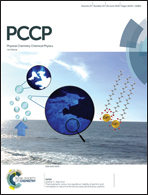Enhanced electronic and optical properties of three TMD heterobilayers†
Abstract
The physical and chemical properties of monolayers can be tuned by selective combinations so as to be useful for device applications. Here we present a density functional theory study on the structural, electronic and optical properties of three transition metal dichalcogenide (TMD) heterobilayers, ZrS2/HfS2, ZrSe2/HfSe2 and SnS2/SnSe2. These heterobilayers are predicted to be energetically and dynamically stable structures. The band structure calculation result shows that ZrS2/HfS2, ZrSe2/HfSe2 and SnS2/SnSe2 heterobilayers are semiconductors with indirect band gaps. The efficient charge carrier separation in ZrS2/HfS2 and ZrSe2/HfSe2 heterobilayers indicates that they can be employed in energy harvesting devices. Contrary to the previous report on the ZrS2/HfS2 heterobilayer, we found it to have an intrinsic type-II band alignment which is required in p–n junction diodes and tunnel field effect transistors, and the same behavior was observed in ZrSe2/HfSe2 and SnS2/SnSe2 for the first time. The ZrS2/HfS2 and ZrSe2/HfSe2 heterobilayers reveal enhanced optical absorption both in the ultraviolet and visible regions as compared to their respective monolayers, whereas the parallel and perpendicular part of the optical absorption of the SnS2/SnSe2 heterobilayer revealed an anisotropic behavior; the perpendicular part is largely improved in the higher energy region, and the parallel part of the optical absorption is improved in the ultraviolet region.



 Please wait while we load your content...
Please wait while we load your content...